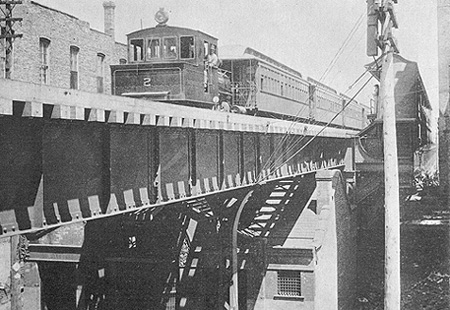
South Side Rapid Transit
Forney Engine #2 leads a multi-car train of wooden trailers
as its passes 39th Street is 1893. The station house is seen
below the tracks. The humped-roof canopy was typical of the
S.S.R.T.'s first stations. (Photo
from the Chicago Historical Society
Collection)
|
Pershing Road
(3900S/1E)
Pershing Road and State
Street, Douglas
Service
Notes:

|
South Side
Division
|
Quick Facts:
Address: TBD
Established: June 6, 1892
Original Line: South Side Rapid Transit
Previous Names: 39th Street
Skip-Stop Type: n/a
Rebuilt: n/a
Status: Demolished
History:
39th Street was one of the original ten stations of Chicago's
first "L" line, the South Side Rapid Transit. The original station
building was a brick grade-level structure built in 1892. The
platform canopy featured an arched roof, similar to that at the
Congress Terminal, a design typical
of the first ten "L" stations. The first train run on the line was
one of six operated Friday, May 28, 1892. It was said to make the
four mile run in 10 minutes with 300 VIP guests. At 39th Street, they
examined the structure while a lunch car was taken on from which a
snack was served on the return to trip to Congress.
On the way, the train stopped at all stations, allowing the guests to
examine them as well. Revenue service began June 6.
In 1907, as part of an ordinance to allow the South Side Line to
install a third track for express service, all stations north of
43rd Street, including this one, were
required to replace their grade-level facilities with mezzanine-level
stations, clearing the alley way beneath the tracks. Because the
tracks' original elevation was not built with the height clearance of
mezzanine-level stations in mind, the portions of the trestle at
station locations had to be slightly raised, creating roller
coaster-like humps in the structure. The occasional rise and descend
can still be seen in the South Side Green Line's tracks.
Adjacent to the 39th Street station was a small facility where the
South Side's steam engines were serviced. Included in the S.S.R.T.'s
original construction, the 39th Street facility was later augmented
by a large engine house built at the 61st Street Yard. Coal for the
locomotives was received from the Chicago Junction Railway, which ran
parallel to 40th Street, making 39th an ideal location for such a
function.
By 1898, the South Side Elevated Railroad had fully converted from
steam locomotives to electric traction. A power house was needed (the
"L" didn't start purchasing power from ComEd until Sam Insull's time)
and 39th Street was again chosen as a suitable location. The
engineering firm of Sargent & Lundy was hired to supervise the
electrification, which provided 600 volts d.c. to cars via an
uncovered third rail. The power house measured 200 feet in length by
100 feet wide, divided lengthwise into two long rooms. The engine
room house four cross-compound condensing Allis-Corliss engines rated
at 1200 h.p. each. These drove four Westinghouse 850 k.w. generators.
In 1900, an adjacent Chicago City Railway barn was demolished and the
engine house was enlarged, adding two more Corliss engines and two
1600 k.w. Westinghouse generators. Coal was still received from a
connection with the Chicago Junction Railway at 40th Street. The
facility stayed in service until 1914, when the elevated companies
began purchasing power from Commonwealth Edison.
This station was one of 23 Howard, Jackson Park, Englewood and
Ravenswood stations closed (including 18th, 26th, 29th, and 31st
to the north) August 1, 1949 as part of the CTA's institution of A/B
skip stop service on the North-South Route. It was eventually
demolished.



